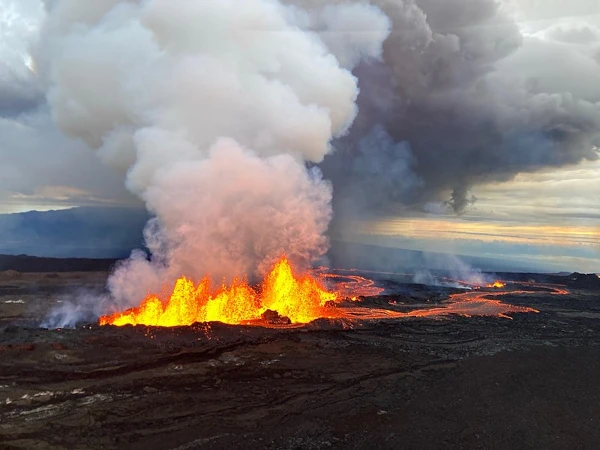
Image description: Mauna Loa (Hawaii). Aerial view on November 29 of lava fountains during the 2022 eruption. Credit: This image is in the public domain.
Mauna Loa, located on the island of Hawaii, is often referred to as the largest volcano in the world. This claim is based on several geological criteria that set it apart from other volcanoes.
The primary criterion that makes Mauna Loa the largest volcano is its volume. With an estimated volume of about 75,000 cubic kilometers, Mauna Loa is not only the largest active volcano but also one of the most massive on the planet. This colossal volume is the result of millions of years of continuous volcanic activity, which has accumulated enormous amounts of lava and volcanic materials.
Although Mauna Loa is not the highest volcano in terms of elevation above sea level, it is the tallest in terms of total height from its submarine base. Measuring about 17 kilometers from the ocean floor to its summit, Mauna Loa even surpasses Mount Everest in total height. This unique characteristic is due to its submarine formation, where most of its structure is hidden under the Pacific Ocean.
Mauna Loa is also one of the most active volcanoes in the world. Its frequent eruptions contribute to its continuous expansion. The resulting lava flows constantly add material to its structure, increasing its volume and mass. This relentless activity is a key factor in its grandeur.
In addition to its impressive size, Mauna Loa plays a crucial role in understanding geological processes. Its volcanic activity provides valuable information about the dynamics of hotspots and the formation of oceanic islands. Studies on Mauna Loa help scientists better understand the Earth's internal mechanisms and the interactions between the lithosphere and the asthenosphere.
Mauna Loa is a giant among volcanoes, not only in terms of volume and height but also in terms of scientific importance. Its colossal size and continuous activity make it a fascinating subject of study for geologists and volcanologists worldwide.